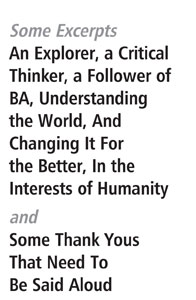Interview with Planetary Scientist Cathy Olkin
The Exciting, Amazing Exploration of Pluto
September 12, 2015 | Revolution Newspaper | revcom.us
In July, NASA's New Horizons spacecraft reached the dwarf planet Pluto after a nine-year voyage and began sending back the first-ever close-up images from the largest body in the Kuiper Belt region beyond the inner planets of the solar system. The following is a transcript of an interview aired September 4 on The Michael Slate Show on KPFK Pacifica Radio with Cathy Olkin, deputy project scientist for the New Horizons mission.
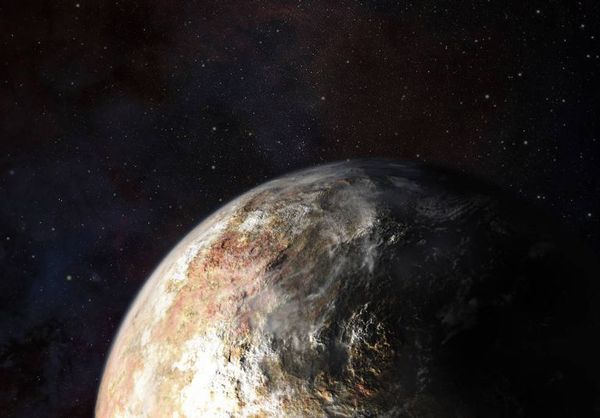
Photographs of Pluto taken from the New Horizons spacecraft July 13, 2015.
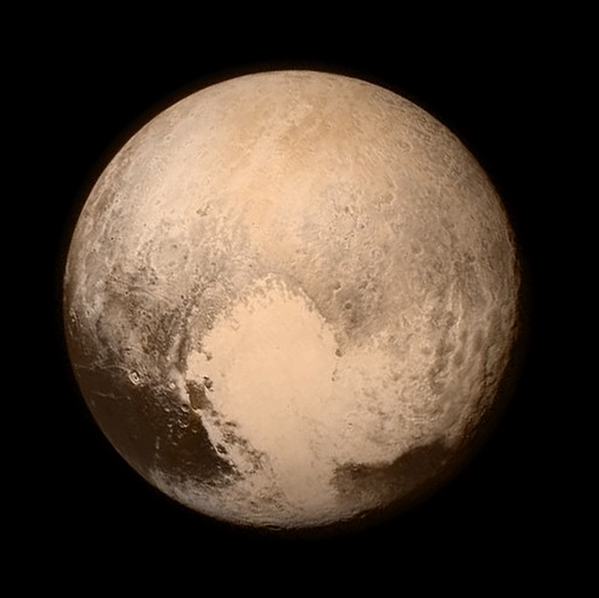
Four images from New Horizons’ Long Range Reconnaissance Imager (LORRI) were combined with color data from the Ralph instrument to create this sharper global view of Pluto.
All photos: NASA/Johns Hopkins University Applied Physics Laboratory/Southwest Research Institute
Michael Slate: I’m very pleased to welcome to the show Cathy Olkin, who is a New Horizons deputy project scientist at the Southwest Research Institute in Boulder, Colorado. She’s a planetary scientist with interest in the icy, outer solar system worlds, and she’s had a helluva time this summer, probably one of the high points of her life, if not the high point. Cathy, welcome to the show.
Cathy Olkin: Thank you for having me.
MS: Sure. Well, me along with everybody else in the world I think, I hope, was just mesmerized and stunned at what happened on July 14 this year, with the exploration of Pluto. To be blunt, I hadn’t really thought about it, didn’t know that much about it and was there even a reason to go there. But, as we got into it, it just sort of ripped open my head and just made me as curious as hell, and also amazed. This was something that was as amazing as it was historic, and that was one of the things I wanted to talk with you about first. The press information from the project says that reaching this third zone of our solar system which is apparently what going to Pluto means—has been a scientific priority for years. Why is that?
Cathy Olkin: It’s been a scientific priority for well more than a decade, to go to Pluto and see what it looks like, as a stepping stone to the Kuiper Belt, which is the third zone of the solar system. When I was in school, I learned about the nine planets. There is the terrestrial planets and the gas giant planets and then there was the misfit, Pluto. But, around about 1992, more objects that shared the similar space as Pluto were being discovered—these Kuiper Belt objects. There’s thousands of these icy worlds in the outer solar system, and we didn’t even know about them just a couple of decades ago. So, one of the main scientific priorities was to go to this region of the solar system and learn about all these bodies that are inhabiting our solar system that we didn’t know about before. Pluto was the largest of these objects. It was discovered in 1930, and so we had known about it for a while. It was the best studied and so what better place to start than by looking at Pluto.
MS: You know, one of the things too though, in relation to that, it’s been a science priority for all the reasons that you’ve been saying, and there’s also something that makes this in and of itself a historic event. I mean I don’t think it’s something that anybody really thought you know, except you guys and others who are in the same world. But you know, if you had asked me like, three years ago, I would have said, “I don’t know what you’re talking about, going to Pluto. What’s going on?” In fact, Pluto had the ignominious push down of, “Oh, you’re not a planet any more buddy—you’re a dwarf planet.” This idea of the historic character of this mission—can we talk about that a little?
Cathy Olkin: Yes, it’s amazing to me. I mean, it is historic. One thing that I think is amazing that Pluto was discovered not that long ago and in some people’s lifetimes, it was discovered and explored. It was amazing at the encounter to have Clyde Tombaugh's children there—they’re grown adults you know, with their own grandchildren now, but to have that close connection to the person who discovered Pluto is really quite astounding. It really is a whole new world—a whole new area that we’re exploring in our solar system, places we’ve never seen before, things we’ve never seen close up and it’s really been transformational in our understanding of our solar system and how the solar system formed, to realize that there’s this reservoir of primordial objects out in the outer reaches of our solar system that are really kind of the remnants of solar system formation. It seems to me quite clear that we needed to go there and see what it was all about.
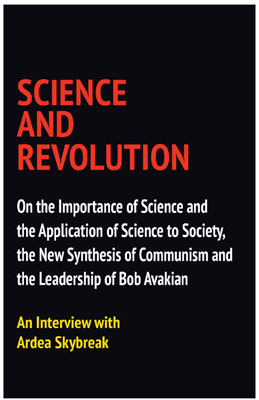
MS: Now getting there, that’s really intriguing in its own right because everything seemed to have to be so finely tuned, worked and reworked before you could even think about embarking on this in order to get there. There was all kind of questions came up: fuel, the energy, the speed, everything. It was a fairly hairy endeavor to get there, wasn’t it?
Cathy Olkin: It was and it was complicated even before the New Horizons Project was funded. People had been trying to get a mission to go to Pluto since the late 1980s. So, there have been lots of false starts. The idea of sending a small spacecraft really quickly with limited instrumentation, or how can we get there in a reasonable amount of time. It took 9 ½ years for New Horizons to traverse the solar system from Earth out to Pluto. That’s a really long time. You need to make sure your computers are working, your cameras continue working—everything needs to be in working order 9 ½ years later. If you think about it, probably not that many people use a computer today that was built more than a decade ago.
MS: What actually changed in the attitude towards getting there, the thing that would unleash you to be able to do that?
Cathy Olkin: One of the big things was there was a decadal survey so, basically consensus in the astronomy community that really we had to go and see this third zone of the solar system—and that was really quite a tipping point for being able to get the project funded and moving forward, but along the way there were many difficulties. One thing is, the power supply for New Horizons is plutonium, and so that’s not something that people have a lot of on hand. The U.S. government had some but it wasn’t quite enough, and so we worked very hard to get the plutonium we needed to make sure we could launch safely.
All the other pieces had to come together to be able to make the mission work out. As we were traveling, we launched in 2006, and it was after 2006 that more small moons of Pluto were discovered. When the project was first proposed, we knew about Pluto and its largest moon, Charon, and then in about 2005, about a year before launch, two more small moons were discovered using the Hubble space telescope. Those are called Nix and Hydra. Then as the spacecraft was traveling out towards Pluto more deep surveys of the vicinity of Pluto were done and, lo and behold, there are two more moons. Those are now named Kerberos and Styx. So, even our understanding of Pluto and its environment was transforming during the years that we were building the spacecraft and traveling out to Pluto.

Observations on Art and Culture, Science and Philosophy
by Bob Avakian
$14.95
Order from Insight Press
MS: Now, one of the things you also came up against, which I thought was really—and I don’t know if this was just my not knowing it, but it was really ingenious—the point that you had to maintain a certain amount of speed to actually get past everything you had to get past in order to even to have a chance of getting to Pluto and this whole idea of the big gravity assist from Jupiter. I was just blown away by that. One, that that was even possible to get that kind of assist—and how that made a critical difference in being able to carry the mission out.
Cathy Olkin: That’s right. Being able to fly past Jupiter was really important because it cut off more than three years of flight time for the spacecraft. Like I was saying before, 9 ½ years is a long time. So you don’t want to have to go more than 12 years in getting to Pluto because then perhaps, computers wouldn’t be working or everything wouldn’t be functioning quite as well. So, it was really important to hit the opportunity of flying past Jupiter. And when we flew past Jupiter, not only did we get the gravity assist but we had an outstanding opportunity to practice using all of our instruments in a real planetary flyby. And so, that was another great thing that came from the Jupiter flyby.
This idea of a gravity assist had been previously done with the Voyager spacecraft and so that in and of itself wasn’t new. But the critical nature of it was in that we were trying to get to our prime target, which was very far out in the outer solar system. The Voyager spacecraft flew past the giant planets and did gravity assist along the way, but their targets were those giant planets and their moons. So, it was inherently different. When we launched, we had a pretty decent window of opportunity for launching the spacecraft—more than a month, but only the beginning part of that month would allow us to fly past Jupiter. So, it was really fortunate that we got off early in our launch window so that we could have that flyby.
MS: One more question on this, maybe two more questions on this, sort of the things behind the scenes that were necessary to get done, in order for this to happen. I also read in a number of spots about the hazards facing the mission, including even a speck of dust no bigger than a grain of rice could have actually just ruined the whole thing.
Cathy Olkin: Yep, that’s right. That’s right. Yeah, we began to become concerned about the potential hazard being in the Pluto environment when Pluto’s small moons Kerberos and Styx were discovered. These small moons along with Nix and Hydra, the other small moons of Pluto, when if something were to hit them, it would like just make a crater and there would be ejecta, or dust being ejected from the surface of the body, where the gravity would pull that dust back down to the surface. It could reach escape velocity and then be in orbit in the Pluto system. So you could imagine that these small moons could be debris generators. They could generate small grains of dust or rock or ice that could be flying around in the Pluto system, and just something the size of a grain of rice, it could go through the spacecraft and take out critical functions, because the spacecraft is flying at about 14 kilometers per second. It’s hard to think in units like that because when you drive a car it’s miles/hour not kilometers/second, but one way to kind of think about it is, if you’ve ever done a 10 kilometer race—people do 10K races all the time—that would be being able to complete it in less than a second. So, that gives you an idea of how fast we are flying through the Pluto system. Because we are going so quickly, even small things were a real hazard, and these small moons could generate these hazards.
So there was a huge effort put on by the project to go back and look at all the possible risks—what could be exposed on the spacecraft, how strong was the insulation that was covering the spacecraft—it’s put there to help equilibrate the temperature of the spacecraft, but you know it also could be a little bit of a barrier. So how strong is that?
Deep searches for more moons of Pluto so that we could know if there were potentially more objects that could generate debris. We had a number of campaigns on approach to Pluto, where we were looking for really small moons. We’d take long exposures and shift a little bit where we were looking, and take another long exposure and look for anything down at the level of noise in the image that could be moving in orbit around Pluto. It was a huge effort, and in the end, we decided that it was safe to fly through the Pluto system, which is really what we wanted because that’s what we designed to get the most scientific return. Then of course, now we’ve flown through the system and we know that it works, so that all worked out well in the end. There was a bit of concern, yeah.
MS: I read a quote from you where you were describing the unprecedented detail about Pluto that was collected and you said that if we dropped New York City Central Park onto Pluto, you would be able to see the ponds in the park. That’s how unprecedented this view is. Clearly this had to require some extraordinary equipment.
Cathy Olkin: That’s right. So, we took really high-resolution imaging. We took imaging of the whole surface of the encounter hemisphere, the side that we flew by, at better than half a kilometer/pixel everywhere. But then we had selected regions that were much higher resolution. We had some resolutions that were on the order of 50 yards. Each pixel would be about 50 yards on an image. So we’ll be able to get amazing detail in many of our images and have gotten some of that data back. But none of the really highest resolution data has come back quite yet.
So it did take a really comprehensive suite of instruments that were designed to do this initial reconnaissance of the Pluto system. We had the LORRI camera, which gives us our highest-resolution data, and it’s what will be giving us those images where you’d be able to count the ponds in Central Park—if you could transport Central Park to Pluto. It’s effectively like an eight-inch telescope inside of New Horizons, and the aperture looks out one part of the spacecraft.
And then we have another instrument called Ralph, and that instrument is really two instruments in one. It’s a color camera and an infrared spectrometer, which really just means it's a way of mapping the composition of the ices on the surface. So there was lots of thought put into how do we have to build the instruments to be able to get the data back that we wanted. The Ralph instrument, the one that takes color images, the field of view of that color camera is almost six degrees, and that’s how large Pluto would look from New Horizons' near closest approach. So it was designed so that Pluto would be filling the whole field of view near closest approach. Those were the sorts of details that went into designing the instruments to return the science that the mission needed.
MS: This information coming back to the Earth is a process that apparently is gonna take about 16 months, so we’ll be looking forward to seeing more and more of that, hearing more and more about that.
Cathy Olkin: Just one point on that. Yes, we had to be very patient to get to Pluto and we have to continue to be patient, because Pluto is very far away and it will take 16 months to get all the data down—but that’s nothing like waiting the 9 ½ years to get there.
MS: Good point. (laughs) And humanity has been waiting for so long for people to be able to think about going there, so that’s a very good point. Carl Sagan said once that somewhere, something incredible is waiting to be known, and I thought that was a good kind of capturing of the spirit of the whole New Horizons Project. I wanted to ask you to talk about some of the things that you thought were the most fantastic that you’ve learned so far about Pluto. One of the things I was thinking about was just the surface of the planet. That just blew my mind, how different it was from what people expected. Can you talk about that a little?
This simulated flyover of two regions on Pluto, northwestern Sputnik Planum and Hillary Montes, was created from New Horizons' close-approach images.
Credit: NASA/JHUAPL/SwRI
Cathy Olkin: Yeah, the planet has just blown me away. The images are stunning and the detail that we’ve seen—I’ve been thinking about what we’d see on Pluto for a couple of decades now and I’ve just been blown away. The mountains that we’re seeing is one thing that is interesting. I expected that we might see some topography, some mountainous areas, but I thought maybe it would be like the rims of an ancient crater basin or something. These mountains don’t seem to be like that, so we’re still trying to understand what caused the mountainous regions that we’re seeing on Pluto.
Another thing that’s just been fascinating is this area that we informally call, Sputnik Planum. It’s in the heart shape that’s on Pluto, which we informally call Tombaugh Regio. In Sputnik Planum, it’s a flat plain of ices and you can see these polygonal shapes with troughs defining the different polygons. There’s dark areas in some of these troughs, some of it sticks up, and there’s this pitted surface where you see details of maybe sublimation with the ices evaporating into the atmosphere. Then in other parts it looks like there might be evidence of flow of these ices. You can see near the northern part of Tombaugh Regio, where it looks like the ices have kind of flowed around some of these mountains or protrusions in the area. It’s just amazing to me the diverse terrain that we’re seeing and the different land forms, and it’s just more than I would have ever expected.
MS: One of the things that surprised me and I think surprised a lot of people is the fact that people often looked at Pluto as being sort of a dead rock. In fact, from what you guys discovered, there’s apparently a lot of ongoing geological events as you’re pointing to, that apparently are showing that the planet is stunningly alive, as one person described it.
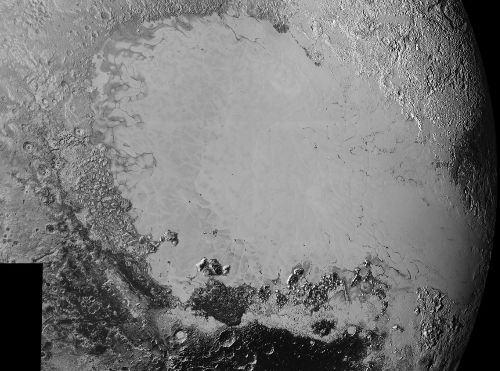
This image, sent back from New Horizons spacecraft September 5-7, is dominated by the informally named icy plain Sputnik Planum, the smooth, bright region across the center.
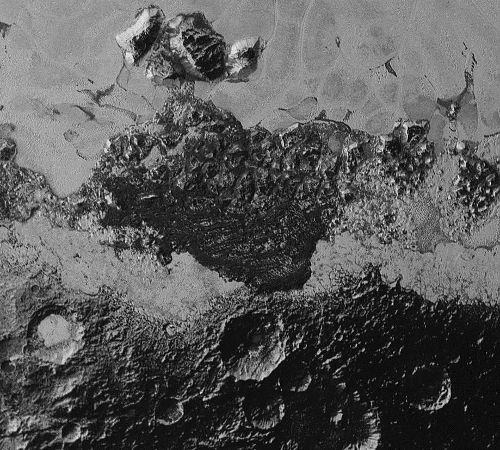
This 220-mile-wide view of Pluto, taken from NASA's New Horizons spacecraft on July 14, illustrates the incredible diversity of surface reflectivities and geological landforms on the dwarf planet.
Cathy Olkin: Yeah. Really, the questions that it brings up is what is powering these flows of the ices across Sputnik Planum. We knew that there’d been changes on Pluto. I’ve been studying Pluto for a long time, and we had seen that the atmospheric pressure on Pluto had changed between 1988 and 2002. We knew that there were some dynamics going on in the system, but the idea of moving ices is just amazing to me. So yeah, this is an active world, and that really makes me and many of my colleagues have to scratch our heads and go back to the drawing boards and try and understand what is powering this. What is the source of heat that would potentially make these shapes that we’re seeing on the surface? So, it’s an exciting time to be a planetary scientist.
MS: Yeah, definitely, and also to be somebody just reading about it, because you guys are doing a hell of a job.
Cathy Olkin: Thank you.
MS: Let’s talk about the atmosphere. That’s another thing that got a lot of people really surprised. The atmosphere on Pluto was very different than what they expected.
Cathy Olkin: That’s right. So, the atmosphere is very different, in a number of different ways, too. One thing that was stunning was the image that we took soon after closest approach where we looked back at Pluto and you could see the hazes being lit up by the sunlight that was behind Pluto. It’s really remarkable, beautiful to see that. First of all that image was just beautiful. And then second of all, it’s stunning because the hazes extend out to about 80 miles above Pluto’s surface. They have layers. You can see details of layers in the hazes when you look closely at the image. It’s astounding to me that the hazes go up that high. And so, we knew that Pluto’s atmosphere was quite extended, but didn’t expect to see hazes up that high.
There had been ongoing debate about whether there were hazes in Pluto’s atmosphere at all. Many of us who thought that maybe there were hazes, or I thought maybe sometimes there was haze and other times there wasn’t, because the ground-based data was kind of hard to understand what we were exactly seeing, but to see the haze extend that far up was just amazing to me.
Then also the New Horizons spacecraft gave the first ever measurement of the atmospheric pressure on Pluto at the surface. We have ground-based observations that you can do where you watch a star pass behind Pluto and you can get an estimate of the atmospheric pressure, but that's up at about 100 kilometers in altitude. But if you look right down at the surface you can’t measure that atmospheric pressure from Earth. So, we needed New Horizons to do that. And the initial part of the data has been returned, and it looks like the pressure in the atmosphere is less than 10 microbars. A microbar is about a millionth the pressure of the atmosphere on Earth. Earth’s atmosphere is primarily nitrogen, as is Pluto’s, but Pluto’s is a much thinner atmosphere. So, we saw that it was 10 microbars. The interesting thing there is that we expected it to be more, based on some ground-based measurements that we had done before. And so that’s a big mystery too. What does this mean about the atmosphere? So a lot of us are digging into this data and trying to understand what’s going on.
MS: Now, one thing that you guys have all talked about is that as the New Horizons Project went past Pluto that it’s going on and it’s actually going to open more doors, and doors that are going to be just as exciting as what was discovered with Pluto, including the Kuiper Belt.
Cathy Olkin: That’s right. So, Pluto shares its orbit, shares its environment, with thousands of other objects. We call all these objects Kuiper Belt objects. These bodies orbit out past Neptune. The New Horizons spacecraft flew past Pluto. We didn’t have enough propellant on board to stop and orbit around Pluto. We knew that when we designed it. We don’t have the capability right now to launch a competent spacecraft with good instruments and be able to orbit Pluto, so we made the choice to fly by, and so we’ve flown by and we will keep going right now. We’ve been searching for other targets out in the Kuiper Belt that we can look at, and our search team identified two potential targets. We will write a proposal to NASA to ask to have what is called, an “extended mission.” Our prime mission was to go to Pluto, and we’ve done that and now we’re getting the data back and analyzing it. But we’re looking forward and we’d love to be able to fly past another Kuiper Belt object so that we could look at more diversity in this system. So, we’ll be writing a proposal to NASA and with any luck we’ll get an extended mission and be able to fly by another Kuiper Belt object and learn more about it. One thing I will say, this other object, both our potential targets, are much smaller than Pluto—more like one of Pluto’s small moons, on the larger side of the small moons.
MS: One of the things that really struck me is that there's this whole point, and I've read it a number of places, that people were saying that when you go into the Kuiper Belt, you're going into this place that's like the furthest outlying region away from the sun. Once you get out of that belt, you go into interstellar space. Then there's a question that comes up. Somebody posed that, in going through the Kuiper Belt and investigating that, it poses the real opportunity, the chance, to really discover things that were not even conceptually possible a little while ago, which is finding the basic ingredients from when the solar system was formed. That's a pretty heavy and amazing possibility, right?
Cathy Olkin: Yeah, it is. These Kuiper Belt objects, one of the reasons they're very interesting is because they're kind of like the building blocks of the planets. They're like the leftover remnants from solar system formation. You can think of the outer solar system as the Kuiper Belt for the solar system. So these are small bodies, that some of them would have accreted into the planets, Mercury, Venus, out to Neptune. But many of those objects out far enough are really the remnants of this solar system formation. So that's part of the reason why we really want to go out there and explore, to see what these bodies look like. What's left in this cold storage? So that's definitely one of our goals.
MS: My last question. Again, quoting Carl Sagan, where he talked about how we live in a world that's really dependent on science these days, more so than ever. But the problem is that so few people in the world actually know about science. In some cases, people are never given the chance to learn science. In other cases, people become very sort of cynical—they get very small-minded and stupid around it. But this mission, one of the things that I was really intrigued by was the approach that what's discovered here as part of this New Horizons mission, it's not going to be people rewriting textbooks but writing whole new textbooks, and that you really strove to put this before the people. Going into it, having some idea of what you might discover, but not having anything for sure, and not even being able to be absolutely positive that you would get all the way there without all the things we were talking about, the hazards and the problems that could jump up. But you guys seem to pursue things from the standpoint of something I think is very important, and that's from the basic human need to be amazed by what we live amongst, and understanding how this all works. I wanted to get your thoughts on that.
Cathy Olkin: Sure, I'd be happy to. Sharing the mission with the world was something that we on the mission team really wanted to do. We're so excited to be exploring Pluto, and we wanted to share that with everyone else, even not knowing what we would see or how it would go. This was exploration. This is exploration that we don't get to do much of any more. There was the time when Lewis and Clark would be exploring the West, or many other different phases of history where there was exploration going on. And this was exploration at its most profound going on today. It just was really important for us to share that with everyone.
Everyone can be excited by learning new things and seeing what's going on with Pluto and what have we managed to accomplish. It was a little risky, because we didn't know what we would see, and we didn't even know if the spacecraft would survive closest approach. We were optimistic. We had done all our homework. We really felt confident in our choice to fly through the system where we chose. But it was important that people could see this in real time, because that's the excitement. One day, no one knew there were mountains on Pluto. And the next day, they were out there and everyone could see: Wow! Look at those mountains on Pluto. Isn't that amazing? The same goes for the glacial ice flows on Pluto, these exotic ices, nitrogen ice and carbon monoxide ice. And imagine being on Pluto and seeing that happen. It's amazing.
I think there's something really immediate. The great thing is, in this day and age, we can share that easily with the Internet and the other ways to extend information, the media outlets. I believe that we had a responsibility to do that so we can excite the next generation, so they can come up with whatever their New Horizons Pluto encounter equivalent will be, when young kids who saw this get to grow up and say, I want to do something like that. It may not be planetary science. It's anything that excites and engages people to say, I'd like to learn more about this, that or the other thing. It's really a responsibility that I think we all understood, that we needed to be open and transparent about what we're learning, when we're learning it, and take the whole world.
MS: And you've done a remarkably good job at that. So thank you very much, Cathy.
Cathy Olkin: Thank you.
Volunteers Needed... for revcom.us and Revolution
If you like this article, subscribe, donate to and sustain Revolution newspaper.

